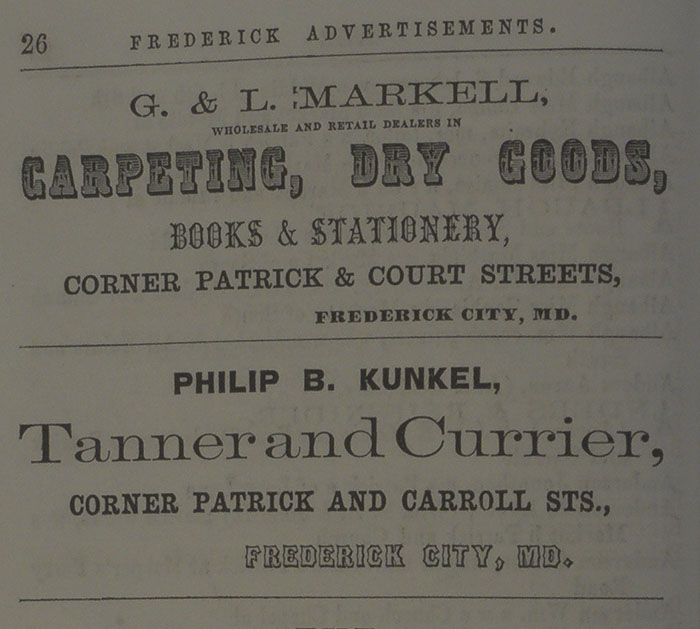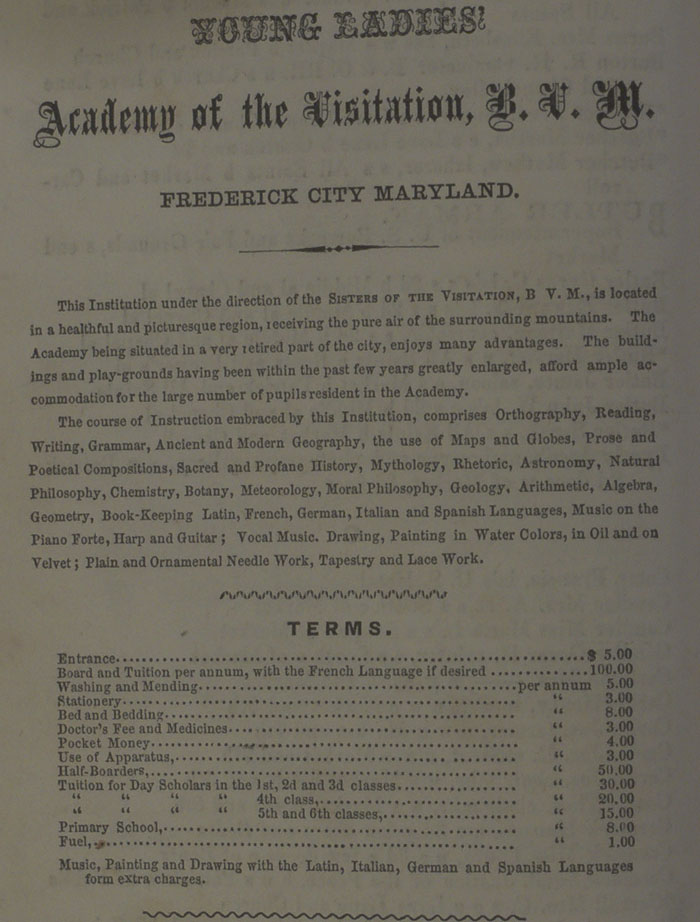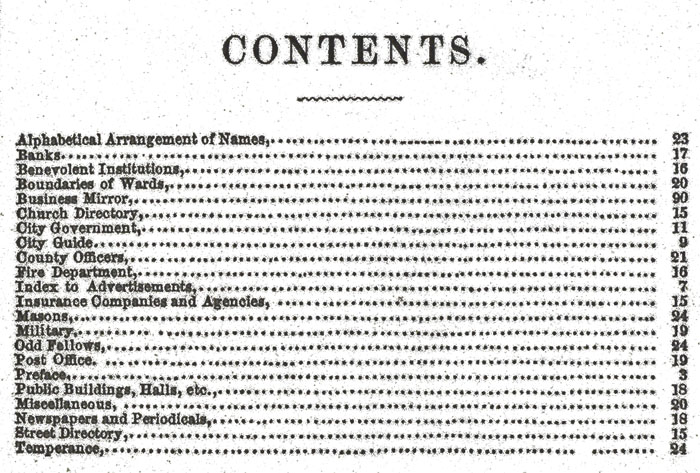The “Williams’ Frederick Directory, City Guide, and Business Mirror, Volume 1–1859-’60” was published in 1859 by the C. S. Williams. A copy was presented to the HSFC on November 19, 1957 by Mrs Bessie P. Keefer of Frederick. I recently had the opportunity to digitize it and create a PDF version with searchable text.
The searchable PDF document is available in the archives of the Historical Society of Frederick County. There is also a searchable HTML version on my website. The HTML code for the directory listing is enhanced with HTML microdata tags that help search engines understand the content of the page. I hope this makes the list of names more accessible to people doing genealogical and historical web searches. The HTML version also contains the un-formatted full text extracted from the PDF file.
This book is a fascinating snapshot of Frederick on the Eve of the Civil War. Here is an image of the Contents page from the directory.
Names For many people, the most important part of the directory is the alphabetical list of names, addresses, and occupations, which are now searchable. We take street numbers for granted, but they had not arrived in Frederick in 1859. Instead street address listings look like: w s Market 3d door n of Church which means West side of Market, third door North of Church. A telling insight into Frederick history, which reflects the deep effects of slavery and race on life in our country, was that fact that the names of “colored” residents are marked with an asterisk. Also of interest are the occupations in the list, many of which no longer exist. Many occupations reflect the fact that Frederick, like most similar towns, was fairly self sufficient. If you wanted leather goods, you could visit you Frederick tanner and currier who could prepare and finish leather to your satisfaction.
Beyond this, I think paging through other parts of the directory is a fascinating experience that gives a remarkable insight into life in Frederick in 1859. I have included here a few samples that particularly attracted my interest.
Government In the City and County Government sections , Wm. G. Cole is listed as the Mayor. Five years later, Mayor Cole was still in office and negotiated the $200,000 ransom of Frederick with the invading Confederate commander, General Early. The city alderman were Geo. Smith, Henry Botler, Lewis Remsburgh, J. A. Ritter, and Lewis Bruner. The County Commissioners were Val. Adams, Michael Shank, R. P. T. Dutrow, Thos. Winter, and H. H. Millin. Many of these families are still prominent in the Frederick community. Z. T. Windsor was the County Tax Collector. His term expired in May 1860. It is interesting that citizens had the opportunity to vote out the tax collector! Daniel Ellis was the Keeper of the Alms House.
Churches Eight churches are listed. Here is a sample. Rev. Wm. Tascar was pastor of African Methodist Episcopal Church on the North side of All Saints near Market. D. Zacharias D. D. was pastor of the Lutheran Church on the North side of Church, east of Market. Rev. P. J. Blenkinsop was pastor of St. John’s Catholic Church at the corner Second and Chapel alley. He assistants were Rev. Francis McAtee and Michael Tuffer.
Streets The street layout information is interesting. Market, Patrick, and Church streets have always been there but some street names have changed. There actually was a Brewers Alley located where South Court Street is today. Love Lane ran north and south near the East Corporation Line. The Corporation Lines were the original boundaries of Frederick. Love Lane later became East Street. I wonder how Love Lane got its name. There are no families named Love listed in the directory. It may that Love came to Frederick for a brief stay and then departed. Middle Alley, a name that has no character whatsoever, was later renamed Maxwell Alley. Public Street (north from Patrick to the Corporation Line, the first street west of Market Street) later became North Court Street. North Street, now 7th Street, was the original Northern boundary. Mantz Street (South from All Saints Street, first street West of Market) became Ice Street. Comparing these streets with a the present map of Frederick City shows that the city has expanded considerably from its Civil War boundaries.
Newspapers There were four newspapers, all weeklies, in Frederick. The Examiner was published by Schley, Haller & Co.; the Republican Citizen was published by Baughman & Norris; the Maryland Union was published by Johnson & Cole; and the Herald was published by John W. Heard.
Ads The directory also has many ads for Frederick businesses and institutions. They present a great picture of everyday life in Frederick. Here is a sample:

The ad for Visitation Academy is particularly interesting. Here is the image:
 The ad shows the “Course of Instruction Embraced” by the Academy of the Visitation B. V. M. (Blessed Virgin Mary) which was run by the Sisters of the Visitation B. V. M. The course included languages, arts, sciences, music, and history. Board and tuition cost $100 plus assorted charges and fees. Tuition for “Day Scholars” ranged from $30 for the lower grades to $15 for the 5th and 6th classes.
The ad shows the “Course of Instruction Embraced” by the Academy of the Visitation B. V. M. (Blessed Virgin Mary) which was run by the Sisters of the Visitation B. V. M. The course included languages, arts, sciences, music, and history. Board and tuition cost $100 plus assorted charges and fees. Tuition for “Day Scholars” ranged from $30 for the lower grades to $15 for the 5th and 6th classes.
The ad also shows the beautiful image of the Academy building shown here:
 Visitation Academy is still in Frederick at the same location.
Visitation Academy is still in Frederick at the same location.
Acknowledgment I want to thank the Historical Society of Frederick County for the opportunity to do the work described here. The Historical Society is a non-profit organization supported by contributions from benefactors, visitors, and users of the historical resources it provides. Everyone is welcome to visit either in person or through it’s web site. Contributions to the HSFC’s work are appreciated and gratefully accepted.

